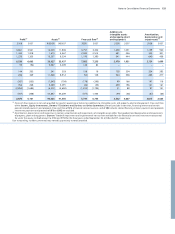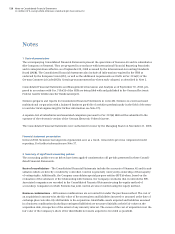Siemens 2008 Annual Report Download - page 230
Download and view the complete annual report
Please find page 230 of the 2008 Siemens annual report below. You can navigate through the pages in the report by either clicking on the pages listed below, or by using the keyword search tool below to find specific information within the annual report.134 Notes to Consolidated Financial Statements
(in millions of €, except where otherwise stated and per share amounts)
The amended standards are effective for business combinations in annual periods beginning on or after July 1,
2009.
In January 2008, the IASB issued an amendment to IFRS 2, Share-based Payment, Vesting Conditions and Cancel-
lations. The amendment claries that vesting conditions are service conditions and performance conditions
only. Other features of a share-based payment are not vesting conditions. It also species that all cancellations,
whether by the entity or by other parties, should receive the same accounting treatment. The amended IFRS 2 is
effective for annual periods beginning on or after January 1, 2009.
3 Management estimates and judgments
Siemens’ Consolidated Financial Statements are prepared in accordance with IFRS. Siemens’ signicant account-
ing policies, as described in Note 2 are essential to understanding the Company’s results of operations, nancial
positions and cash ows. Certain of these accounting policies require critical accounting estimates that involve
complex and subjective judgments and the use of assumptions, some of which may be for matters that are
inherently uncertain and susceptible to change. Such critical accounting estimates could change from period to
period and have a material impact on the Company’s results of operations, nancial positions and cash ows.
Critical accounting estimates could also involve estimates where management reasonably could have used a dif-
ferent estimate in the current accounting period. Management cautions that future events often vary from fore-
casts and that estimates routinely require adjustment.
Revenue recognition on construction contracts – The Company’s Sectors, particularly Energy and Industry,
conduct a signicant portion of their business under construction contracts with customers. The Company gen-
erally accounts for construction projects using the percentage-of-completion method, recognizing revenue as
performance on a contract progresses. This method places considerable importance on accurate estimates of the
extent of progress towards completion. Depending on the methodology to determine contract progress, the sig-
nicant estimates include total contract costs, remaining costs to completion, total contract revenues, contract
risks and other judgments. Management of the operating Divisions continually review all estimates involved in
such construction contracts and adjusts them as necessary. The Company also uses the percentage-of-comple-
tion method for projects nanced directly or indirectly by Siemens. In order to qualify for such accounting, the
credit quality of the customer must meet certain minimum parameters as evidenced by the customer’s credit
rating or by a credit analysis performed by Siemens Financial Services (SFS), which performs such reviews on
behalf of the Company’s Managing Board. At a minimum, a customer’s credit rating must be single B from exter-
nal rating agencies, or an equivalent SFS-determined rating. In cases where the credit quality does not meet
such standards, the Company recognizes revenue for construction contracts and nanced projects based on the
lower of cash if irrevocably received, or contract completion. The Company believes the credit factors used pro-
vide a reasonable basis for assessing credit quality.
Trade and other receivables – The allowance for doubtful accounts involves signicant management judgment
and review of individual receivables based on individual customer creditworthiness, current economic trends
and analysis of historical bad debts on a portfolio basis. For the determination of the country-specic compo-
nent of the individual allowance, we also consider country credit ratings, which are centrally determined based
on information from external rating agencies. Regarding the determination of the valuation allowance derived
from a portfolio-based analysis of historical bad debts, a decline of receivables in volume results in a corre-
sponding reduction of such provisions and vice versa. As of September 30, 2008 and 2007, Siemens recorded a
total valuation allowance for accounts receivable of €1,013 million and €895 million, respectively. Siemens also
selectively assists customers through arranging nancing from various third-party sources, including export
























